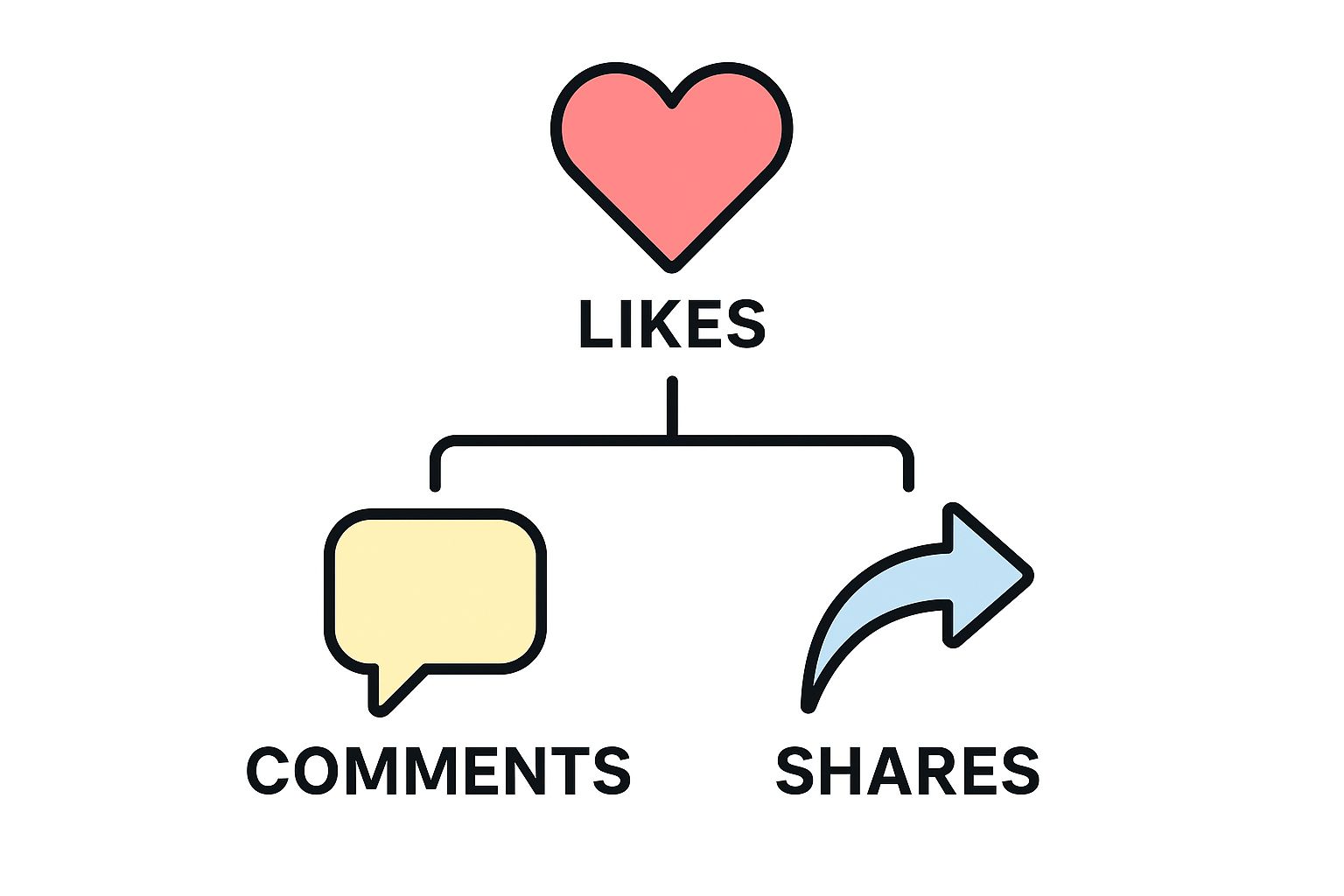Social Media Engagement Metrics That Truly Matter

Social media engagement metrics are simply the data points that show you how people are actually interacting with your content. We're talking about the likes, comments, shares, and saves. These are the most direct signals telling you if your content is genuinely connecting with people or just getting lost in the digital noise.
Why Engagement Metrics Are Your Social Media Compass
Staring at a dashboard full of social media data can feel like you're lost at sea. You see big numbers for reach and followers, but what are they really telling you? This is where tracking the right social media engagement metrics becomes your lifeline, guiding you from aimlessly drifting to charting a direct course toward your goals.
Think of these metrics as your ship's compass. A "like" is a quick nod, a simple acknowledgement. But a "share"? That's a powerful personal endorsement. A "save" is even better—it means your content is so valuable that someone wants to come back to it again and again. These aren't just vanity numbers; they're direct feedback revealing what your audience truly cares about, helping you build a loyal community and drive real business results.
Moving Beyond Guesswork
Relying on guesswork is a surefire way to waste a lot of time and money. When you zero in on engagement, you stop just broadcasting messages and start having a real conversation. This data-first approach helps you:
- Understand Audience Intent: You'll quickly see which topics, formats, and tones make people stop their endless scrolling and actually interact.
- Refine Your Content Strategy: It allows you to double down on what’s working and cut the content that falls flat. It’s all about optimizing your efforts.
- Build a Stronger Community: You'll foster true loyalty by creating content that people feel an urge to discuss and share with their own networks.
In today's incredibly crowded digital space, genuine interaction is the most valuable currency you have. Focusing on engagement is how you turn passive viewers into active participants and, eventually, into loyal advocates for your brand.
The Evolving Nature of Engagement
It's also critical to remember that what "engagement" means is always shifting. For instance, recent benchmarks show a general dip in engagement rates across the major platforms. Facebook saw a 36% drop, while X (formerly Twitter) took an even steeper 48% hit. This is happening because of content overload and constant algorithm changes, which makes having a smart content strategy more important than ever.
But despite that downward trend, some formats are still crushing it. Instagram carousels, for example, have managed to outperform even the ever-popular video reels. This just proves that you have to get into the weeds and understand the nuanced data to win.
To get a much deeper dive into the specific metrics that truly matter and why they serve as your social media compass, you should explore this guide on social media engagement metrics.
Decoding The Four Tiers of Engagement
To really get what your social media engagement metrics are telling you, you have to understand that not all interactions are created equal. It helps to think of engagement as a spectrum, ranging from a casual nod of approval all the way to a passionate endorsement. We can break these signals down into four distinct tiers, with each one revealing a deeper level of connection to your brand.
When you start looking at your metrics this way, you move beyond just counting likes and comments. You start to see the real story behind the numbers—and how your content is truly performing.
This infographic gives a great visual breakdown of how the most common forms of engagement relate to one another.

You can see how likes, comments, and shares aren't just a jumble of numbers. They represent a ladder of audience investment, climbing from simple acknowledgment to active participation and, finally, advocacy for your brand.
To make this even clearer, let's break down what each tier means for your strategy and what specific metrics fall into each category.
The Four Tiers of Engagement Metrics
| Metric Tier | Specific Metrics | What It Measures | Strategic Value |
|---|---|---|---|
| Tier 1: Applause | Likes, Reactions, Video Views | Passive Acknowledgment: The audience saw and acknowledged your content. | Good for gauging initial visibility and resonance. Think of it as a surface-level pulse check. |
| Tier 2: Amplification | Shares, Retweets, Quote Tweets | Active Endorsement: The audience valued your content enough to broadcast it to their network. | Extends your organic reach and provides powerful social proof. It's a vote of confidence. |
| Tier 3: Conversation | Comments, Replies, Mentions, DMs | Community Building: Your content sparked a direct interaction or discussion. | Creates genuine connection and loyalty. These are prime opportunities to build relationships. |
| Tier 4: Conversion | Link Clicks, Saves, Form Fills | Tangible Business Action: The audience took a step that moves them closer to a business goal. | Directly proves ROI by linking social media efforts to concrete outcomes like leads or sales. |
This table gives you a framework for not just tracking metrics, but valuing them. A single share (Amplification) often carries more weight than dozens of likes (Applause) because it actively grows your audience. Let's dig a little deeper into each one.
Tier 1: Applause Metrics
The first and most basic tier is Applause. These are the quick, low-effort interactions a user can make in a split second.
- Likes and Reactions: A simple tap to show approval.
- Video Views: A user pausing to watch, even for just a few seconds.
Think of Applause metrics like polite clapping after a performance. They're a signal that your content was seen and got a nod of approval, which is a decent start. But on their own, they don't prove a deep connection or a lasting impact.
Tier 2: Amplification Metrics
Next up is Amplification. This is a huge step up because it represents a user actively choosing to show your content to their network. It's one of the most powerful forms of social proof you can get.
Amplification is a direct endorsement. When someone shares your post, they're putting their own reputation on the line to vouch for your content.
A share is almost always more valuable than a like. Why? Because it transforms a passive viewer into an active promoter for your brand, introducing you to new audiences with a layer of built-in trust from the person who shared it.
Key amplification metrics include:
- Shares (or Retweets): The classic amplification metric. The user simply reposts your content to their own feed.
- Quote Tweets: Even better. This is when a user shares your post but adds their own commentary, creating a whole new layer of conversation and context.
Tier 3: Conversation Metrics
The third tier, Conversation, is where a real community starts to take shape. These metrics show your content was compelling enough to make someone stop, think, and actually respond.
- Comments and Replies: Direct feedback, questions, or discussions happening right on your post.
- Mentions: When users talk about your brand in their own posts, pulling you into their world.
- Direct Messages (DMs): A user taking the initiative to start a private, one-on-one conversation.
These interactions are pure gold for building relationships. A thoughtful reply to a comment can easily turn a casual follower into a loyal fan. This is especially true on professional networks like LinkedIn, where meaningful discussion is key. For more on that, check out our guide on the 7 types of content to boost your presence on LinkedIn.
Tier 4: Conversion Metrics
Finally, we have the most powerful tier of all: Conversion. These are the metrics that tie your social media work directly to tangible business results. They show the highest level of intent, where a user takes an action that moves them down your marketing funnel.
This could mean clicking a link to your blog, saving a post for later reference, or even making a purchase. These are the metrics that definitively prove the ROI of your entire social media strategy.
So, How Do You Calculate Your Actual Engagement Rate?

Alright, so you know what engagement is. But how do you boil down all those likes, shares, and comments into one single number that actually means something? That's where your engagement rate comes in. It’s your go-to metric for seeing if your content is truly hitting the mark or just floating by.
Here’s the thing, though: there's no single, universally accepted formula. The "right" way to calculate it really depends on what you're trying to figure out. Are you curious how many people who saw your post actually cared enough to interact? Or are you more focused on how loyal your entire follower base is?
Each approach tells a different story.
The Three Main Ways to Calculate Engagement
Picking the right formula is key because each one shines a light on a different aspect of your performance. Let's walk through the three most common methods so you can choose the one that fits your goals.
Engagement Rate by Reach (ERR): This is, hands down, the most honest way to judge your content's quality. It answers a simple question: Of all the people who saw this post, what percentage of them took action?
Engagement Rate by Impressions (ERI): This one is especially handy for paid campaigns. It looks at how often your post was engaged with compared to the total number of times it was shown, even if the same person saw it multiple times.
Engagement Rate by Followers (ERF): This is a solid metric for keeping an eye on the general health and loyalty of your audience over time. Be aware, though, that it can be a bit misleading for individual posts since not all your followers will see everything you publish.
Let's See These Formulas in Action
Theory is great, but let's make this real. Imagine you've published an Instagram post and the stats look like this:
- Total Engagements (Likes + Comments + Shares + Saves): 500
- Reach: 5,000 people
- Impressions: 7,500 times
- Total Followers: 10,000
Here’s how the math shakes out with each method:
Engagement Rate by Reach (ERR) (500 Engagements / 5,000 Reach) x 100 = 10% ERR This tells you that a solid 10% of the unique people who saw your post found it compelling enough to interact.
Engagement Rate by Impressions (ERI) (500 Engagements / 7,500 Impressions) x 100 = 6.67% ERI This shows you the engagement frequency for every time your post was displayed.
Engagement Rate by Followers (ERF) (500 Engagements / 10,000 Followers) x 100 = 5% ERF This reflects how engaged your followers are, relative to the total size of your community.
See? The exact same post gives you three completely different numbers. Each one offers a unique lens for viewing your social media engagement metrics. While these formulas are a fantastic starting point, they're just one piece of the puzzle. For a complete picture, it's vital to understand the other crucial social media metrics you should track.
And if you want to go even deeper on this topic, check out this excellent guide on how to measure social media engagement.
What a Good Engagement Rate Actually Looks Like

So, you've crunched the numbers and calculated your engagement rate. The next question is always the same: "Is this any good?"
Here’s the hard truth about social media engagement metrics: there is no single magic number. A "good" engagement rate is a moving target, and it depends almost entirely on your industry, your audience, and most importantly, the platform you're using.
Comparing your Instagram engagement to your LinkedIn performance is like comparing apples and oranges. Each platform has its own algorithm, its own user behaviors, and its own content expectations. That context is everything. Without it, you’re just staring at data in a vacuum, which can lead to setting the wrong goals or thinking your strategy is failing when it's actually doing great for that specific channel.
Platform Benchmarks Matter Most
Think of each social platform as its own little ecosystem. What’s considered normal in one might be extraordinary in another. For instance, a 2% engagement rate on Facebook would be fantastic, but on TikTok, it might just be middle-of-the-road. Why? Because each platform's algorithm is wired to reward different kinds of interactions.
Recent data paints this picture perfectly. An analysis of over 125 million posts showed massive differences across channels. TikTok absolutely dominates with an average engagement rate of 2.50%, thanks to an algorithm built for pure, unadulterated video engagement. Meanwhile, established giants like Facebook and X (formerly Twitter) see much quieter averages, hovering around a mere 0.15%. You can dig into the full social media benchmarks study to see how your specific industry stacks up.
This huge gap is exactly why you have to judge each channel on its own terms. Chasing a TikTok-level engagement rate on your Facebook page is just a recipe for frustration.
Setting Realistic Goals Based on Context
So, how do you set goals you can actually hit? The best place to start is by benchmarking against yourself. Your primary goal should always be steady, incremental improvement month over month. Once you have that baseline, you can start looking at industry-specific data for a wider perspective.
A "good" engagement rate isn't a number you borrow from someone else's report. It's one that consistently grows over time, proving your content is resonating more deeply with your audience on that platform.
Here are a few practical steps to put this into action:
- Analyze Platform by Platform: Forget about a blended average. Dive into your numbers for Instagram, LinkedIn, and TikTok separately. Each one tells a different story.
- Track Your Own Trends: Is your engagement on a specific channel trending up or down over the last 3-6 months? This is your most important benchmark.
- Find Your Winners: Look at the individual posts with the highest engagement on each platform. What do they have in common? Use those insights to shape what you create next.
By focusing on context and your own progress, you can stop chasing arbitrary numbers and start making smart decisions that lead to real, measurable growth where it truly counts.
Actionable Strategies to Increase Your Engagement
Knowing your engagement metrics is one thing; actually improving them is a whole different ball game. It’s time to put that data to work. The real secret is shifting your mindset from simply broadcasting content to sparking genuine, two-way conversations with your audience.
https://www.youtube.com/embed/o_WPyDaADeU
The strategies below are practical, straightforward, and designed to help you build a more interactive and loyal community. This isn't about posting and praying. It's about giving your audience a reason to jump into the conversation. Whether you’re a small local shop or a global brand, these tactics will help you build momentum and see a real difference in your numbers.
Spark Conversations with Questions
One of the easiest yet most powerful ways to get people talking is to just ask them something. Seriously, it's that simple. Instead of making a statement, frame your post as a question to invite a reply. This small tweak completely changes the dynamic from a monologue into a dialogue.
- Ask for opinions: "We're playing with a new logo design. Which one catches your eye more, A or B? Drop your vote in the comments!" This makes your audience feel valued and part of your brand's story.
- Pose thought-provoking questions: A coffee shop could ask, "What’s the one coffee gadget you absolutely can't live without?" This taps directly into your followers' daily routines and passions.
- Use fill-in-the-blanks: "My go-to productivity hack is ______." This is super low-effort for your audience and can rack up a ton of quick, fun responses.
This works because you’re giving people a clear and simple prompt. You aren't just hoping they'll comment; you're directly asking them to. To take this even further, check out our complete guide on how to boost social media engagement for more advanced tips.
Run Interactive Polls and Quizzes
Polls are an engagement goldmine. They are fun, fast, and let people share their opinion with a single tap. Platforms like Instagram Stories, X (formerly Twitter), and LinkedIn have made creating them incredibly easy.
Quizzes take things up a notch by adding a layer of entertainment and a personalized result, which encourages people not just to participate but to share. A brand selling outdoor gear could create a quiz like, "What's Your National Park Personality?" It provides value and a bit of fun, making your brand that much more memorable.
Interactive content like polls and quizzes does more than just give your social media engagement metrics a temporary bump. It actually trains your audience to view your account as a source of fun and participation, making them more likely to engage with you again and again.
This strategy is particularly crucial in today's packed social feeds. With the global user base jumping by 4.7% in the last year and people spending over 14 billion hours on social media every single day, you need content that truly stands out. It's no wonder that 73% of businesses using AI for content creation report a real lift in engagement—it helps cut through the noise.
Embrace User-Generated Content
User-Generated Content (UGC) is the ultimate form of social proof. It’s when your customers become your creators. When you feature content made by the very people who use your products, you win on multiple fronts:
- You get authentic content without having to create it from scratch.
- You make the featured customer feel seen and valued, which builds incredible loyalty.
- You show potential customers that real people—not just marketers—love and use your stuff.
A great way to encourage UGC is to create a unique branded hashtag and run a contest around it. For instance, a fitness apparel brand could ask customers to share their workout photos using #BrandActive for a chance to win a prize. This not only populates your content calendar but also builds a vibrant, authentic community around your brand. To really level up your strategy, explore these top social media engagement tips and turn your feed from a monologue into a buzzing hub of activity.
Engagement Metrics: Your Questions Answered
Diving into the world of social media engagement metrics can feel a bit like trying to learn a new language. You get the basics down, but then the real-world questions start popping up. This section is here to clear the fog and give you straightforward answers to the questions marketers are asking every single day.
Think of this as your go-to guide for putting what you’ve learned into practice. No jargon, just direct answers to help you move forward with confidence.
Which Social media Engagement Metric Is Most Important?
This is the million-dollar question, but the answer is surprisingly simple: there isn’t one. The "best" metric is completely tied to what you're trying to achieve with a specific post or campaign. It’s all about matching the metric to your mission.
- For Brand Awareness: If you just want to get your name out there, your north star is Reach. This number shows you how many unique people saw your content, making it the clearest signal of how far your message is traveling.
- For Content Resonance: Want to know if your content actually landed with your audience? Look at Shares and Saves. A share is the ultimate compliment—someone liked your content enough to put their own name on it. A save means it was so valuable they want to come back to it again.
- For Community Building: When the goal is creating a genuine community, Comments are everything. This is where the real conversations spark, relationships are built, and you get unfiltered feedback straight from your audience.
The smartest approach? Decide on your goal first, and then pick the metric that tells you if you're getting closer to it.
How Often Should I Track My Engagement Metrics?
Finding the right rhythm for checking your metrics is key. If you check too often, you'll drive yourself crazy reacting to every tiny dip. If you check too rarely, you’ll miss crucial trends that could have changed your strategy. You need a balance.
A weekly check-in is perfect for spotting trends and seeing what’s working without getting bogged down in daily noise. Then, block out time for a deeper, more strategic look on a monthly or quarterly basis.
This cadence keeps you agile enough to tweak things week-to-week while still keeping your eyes on the big picture and your long-term business goals.
Are Vanity Metrics Like Likes Completely Useless?
Not entirely, but you need to see them for what they are. Likes are like a quick round of applause—a simple, low-effort nod that says someone saw and acknowledged your content. They’re a decent pulse check for what initially grabs people’s attention.
But that's where their usefulness ends. They don’t tell you anything about deep connection or intent the way Shares, Saves, or thoughtful Comments do. Think of them as a starting point for your analysis, but never make big strategic moves based on Likes alone. They're a tiny piece of the puzzle, not the whole picture.
My Engagement Is Low. What Should I Fix First?
If your engagement numbers are in a slump, the very first place to look is your content. Nine times out of ten, low engagement is a content problem, not an algorithm problem.
Before you blame the platform, do a quick, honest content audit. Are you genuinely providing value, or are you just talking about yourself? Look at your handful of best-performing posts—what do they have in common? Usually, low engagement is a symptom of content that's too salesy, visually boring, or doesn't give people a reason to interact. Start by experimenting with new formats, asking more questions, and making a shift from selling to solving.
Ready to turn your content into visually stunning carousels that stop the scroll and supercharge your engagement? With Lumeo, you can effortlessly transform articles, tweets, and even YouTube videos into compelling presentations optimized for LinkedIn and Instagram. Start creating high-impact visual assets today and see what Lumeo can do for your brand. Try Lumeo for free.